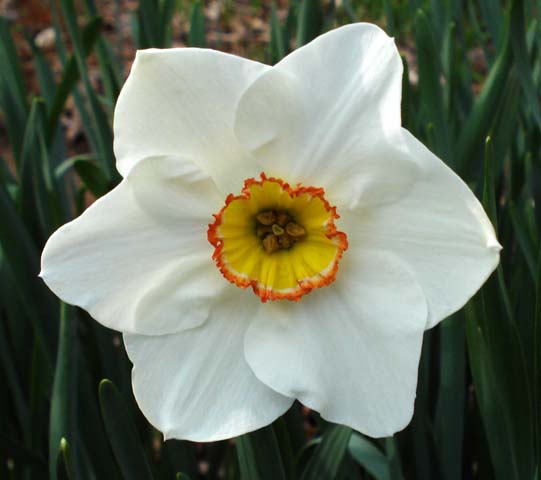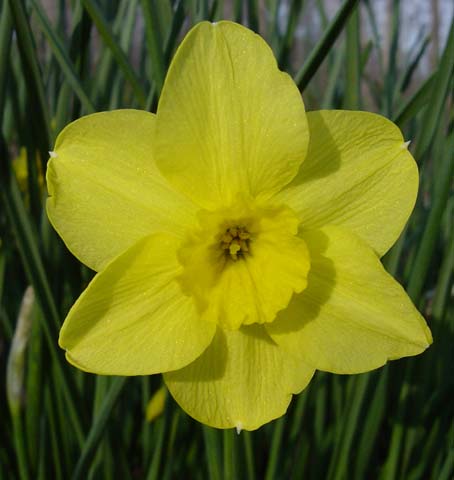Virginia Bluebells (Mertensia virginica) is one of my favorite spring wildlowers. The cool blue-green foliage is attractive, but it's the flowers, especially the color combinations provided by the pink buds and blue flowers in the same raceme that really get me excited. I think you'll see what I mean when you view this sequence of three pictures I took of the same plant growing in the garden, one each day, starting on March 26.
Wednesday, March 28, 2007
Springtime on Crowley's Ridge: Almost Heaven
The spring peepers are peeping; there’s a green haze through the woods and the air is warm and caressing. Yep, spring has once again come to Crowley’s Ridge.
This ridge is a unique landform, an upland in the lowlands, which rises in southern Missouri and extends southward 150 miles into northern Arkansas where it tapers off west of Memphis, Tennessee. Poking above the surrounding floodplain, it resembles an island in the middle of an ocean. Windblown loess, easily eroded, gives many parts of the ridge its rugged, distinctive deep ravines and steep bluffs which rise to 550 feet.
Some geologists think that this narrow ridge is the strip between the two old channels of the Mississippi River while others believe it was uplifted by a folding of the earth’s crust. Since the area elevation has increased over the years, this theory has some credence.
The vegetation on Crowley's Ridge is more like that found in the Appalachian Mountains to the east than the closer Ozark Mountains to the west. Examples are the American beech (Fagus grandifolia) and the Tuliptree (Liriodendron tulipifera), a yellow poplar which in this area is found growing wild only on the ridge. Ferns and wildflowers abound here from early spring to late fall.
Traditional images of pearly gates and streets of gold have never attracted a plant geek like me but the little woodland plants that are common on Crowley’s Ridge and native to much of the eastern United States are a source of great joy – heaven - to me!
Podophyllum peltatum![]()
Our woods are full of May-apple (Podophyllum peltatum) which at maturity are 12-18 inches. Opening in April, the waxy, white flower attached to the crotch of two large umbrellalike leaves is usually hidden. The edible fruit ripens in May, hence the name.
Dentaria laciniata
The tiny Cut-leaf Toothwort (Dentaria laciniata) is also common in our woods. According to the Doctrine of Signatures, a plant that looked like part of the body was good for treating ailments of that part. Since the small flower in bud resembles a tooth, it was thought to be useful in treating teeth problems. This concept was employed by the herbalists of the Renaissance, and was accepted until the latter part of the 19th century.
Sanguinaria canadensis
Another plant that thrives on Crowley’s Ridge is the Bloodroot (Sanguinaria canadensis). The pale green, palmate, lobed leaf is wrapped around the single, short-lived, dazzling white flower as it emerges and opens.
Though these spring flowers are quickly gone, pausing to open ourselves to their fleeting beauty is to enter into the great cycle of life.
Earth's crammed with heaven.....
- Elizabeth Barrett Browning
Monday, March 26, 2007
Tulips in the Deep South

When most people think of southern cultural idioms, fields of tulips are not one of them. Tulips are generally, and rightfully, considered difficult to grow here in the Deep South.
Despite this difficulty, there are a number of tulips that we can grow as perennials in the south.
The tulip in the first photograph is Tulipa saxitilis. It has tough, thick and persistent foliage and a branched small inflorescence. I like this one, but it has been slow to establish after my initial planting a year and a half ago.

Those that have survived appear to be doing well this year, although some of the flowers appear to be damaged by rot or virus. I hope one year to have many more of these.
Another tulip that I'm growing is Tulipa clusiana , although I think I have a cultivar, it was sold as the species. It has hung around the garden for years, although I have often disturbed them as I forget where they are.
The plant is stoloniferous and should spread once I leave it alone in its home. We'll see if it does this eventually.

Tulipa 'Queen of Sheba' is the strongest performer of all that I am growing. It is a large hybrid lily flowered tulip but it performs great in my garden, unlike most of its ilk.
A gardener from Argentina turned me on to this variety and I've also seen it referenced in some literature I found from NC State. They have an extensive list of Tulips for southern gardens.
Look here for NC State's list: http://www.ces.ncsu.edu/depts/hort/consumer/quickref/flowers/tulip.html
In its second year in the ground it is bigger than last year and is still present in most of the places I planted it.
The few that have disappeared were located in areas of high disturbance. I will replace those that I have lost and I have no doubt that I will see this plant for years to come.
This fall and into the next I will be increasing the number of tulips in areas where critters won't be much of an issue. Squirrels and their furry friends find that tulips are like chocolate. My more formal, less wooded beds aren't frequented by furry friends and are fine for these and other delicacies.
Although I can't imagine tulips becoming a mainstay in the garden, I will continue to make room for these three and a few other varieties I have yet to try.
Wednesday, March 21, 2007
Spring Beauty
While it's true that spring is upon us and beauty can be observed readily, that's not the meaning of this post's title. Instead it refers to a tiny native wildflower, Claytonia virginica, that goes by the common name of Spring Beauty. It grows in profusion alongside the creek and it's one of the first wildflowers to bloom here each spring. The flowers on the plants in our population vary from pure white to pale pink, but my favorites are white with pink stripes.
Monday, March 19, 2007
'Accent', 'Avalanche', and 'Tullybeg'
We had a real taste of spring last week with high temperatures near 80°F for several days in a row. That ended Friday with the arrival of heavy rain and wind and much colder temperatures following. Before the stormy weather arrived I got some pictures of the varieties of Narcissus coming into bloom.
'Accent' is the first pink-cupped Narcissus to bloom in the garden and like all pink daffodils the color is more accurately described as salmon because there is always some orange present. Each flower opens with white petals and a light yellow cup, which darkens to a rich salmon, fading to a paler salmon before the flower finally withers.
'Avalanche' is the first tazetta to bloom in the garden. It's also called 'Seventeen Sisters' because of the large number of small, extremely fragrant flowers that open on top of its sturdy scapes. Its foliage is fairly broad and gray-green. It tends to emerge early here and the tips often show cold damage. The damaged tips are easily trimmed off if desired, either way it doesn't seem to impact the plant's vigor.
'Tullybeg' is the first small-cupped Narcissus to bloom in the garden. Its coloration, white petals with an orange-rimmed, yellow cup, show its N. poeticus ancestry.
Sunday, March 11, 2007
'Delibes' and 'Trevithian'
We continue to have ideal weather for the late winter daffodil display, alternating between brief warm spells, during which more flowers open, and cool, which helps them last. This post will feature two Narcissus, 'Delibes' and 'Trevithian', which started blooming a few days ago and now have enough flowers open to photograph.
Narcissus 'Delibes' attracts attention with its deep yellow petals and wide, flat, ruffled, orange-rimmed cup. Its flower form looks much like N. 'Ice Follies' and not surprisingly, it's also classified as a large cup. It's been a reliable bloomer in the garden and multiplied at a slow, steady rate.
Narcissus 'Trevithian' is the first jonquilla hybrid to bloom in the garden. Each scape bears very fragrant, deep yellow, medium-sized flowers in small clusters. It has very narrow, dark green foliage, usually taller than the flower scapes, which I had to part to get a clear view of the flowers for the close-ups, but this not as much of a concern in the garden because the foliage is so wispy. Like 'Delibes', it's been a reliable bloomer in the garden and multiplied at a slow, steady rate.
The next Narcissus to bloom in the garden will be the small-cupped 'Tullybeg', followed shortly after by the pink-cupped 'Accent'.
Friday, March 9, 2007
Emerging Buckeyes
While photographing Lindera benzoin flowers yesterday I noticed the beautiful emerging foliage of Painted Buckeye (Aesculus sylvatica), also abundant alongside our creek. I love the crinkled texture and blending of colors of their emerging compound leaves, always the first of the native woody plants to unfurl their leaves here in central North Carolina.
I sent pictures to Alani, Bodhisagan, and a few other plant geeks without blogger ids, suggesting that A. sylvatica might be a good subject for a blog post and soliciting their feedback. The consensus was to go ahead and post, but Alani also sent a picture of Red Buckeye (Aesculus pavia) foliage emerging in north Florida, so I've included his picture here too.
Update on March 11: Bodhisagan mentioned that it might be interesting to check on their progress in a few days, so here is a shot of the exact same buds about 48 hours later. As Bodhisagan suspected, they've grown rapidly.
Update on March 21: My favorite buckeye of all has now leafed out. It's bottlebrush buckeye, Aesculus parviflora, which has beautiful late spring flowers and stunning bright yellow autumn foliage.
Update on March 26: Wild Child sent her sketch of a young Aesculus pavia she found in Village Creek State Park, Arkansas on March 20. I thought it was cool so I included it here.
Wednesday, March 7, 2007
Japanese Spicebush
After all the posts about mostly yellow Narcissus, my last one featured a combination of flower colors with a patriotic theme, but I'm back into yellow again. It's not a Narcissus providing the yellow this time, instead it's Japanese Spicebush, Lindera obtusiloba, a shrub that I grow mostly for its brilliant fall color and beautiful aromatic foliage like that of Sassafras, with left-handed mitten, right-handed mitten, and three lobed versions. Additional interest is provided by the small yellow flowers that line its bare branches in late winter. They're not really showy, many people would walk right by without noticing them, but I like them anyway.
The native spicebush, Lindera benzoin, is very abundant alongside our creek. It's mostly absent from the upland areas around the house and garden, but I've found seedlings growing among the Hostas and ferns in moist soils on the northeast side of the house and have transplanted them to suitable locations along the forest edge. Like its Asian relative, it has small yellow flowers in late winter and is aromatic in all of its parts, including the showy red autumn berries, but its foliage is simple without the fancy lobes.
My next post will probably feature Narcissus again because today I noticed the first flowers opening on 'Trevithian', 'Delibes', and 'Accent'. Adding some blue to the mix I also saw quite a few Scilla sibirica getting ready. As soon as I get some good photos I'll share them here.
Monday, March 5, 2007
Patriotic Effects
Many early Narcissus are mostly yellow, with some variety added by the orange cups of 'Ceylon', 'Jetfire', and 'Pinza' and the pale 'Ice Follies', but it's nice to see some other colors in the garden at this time of year. As the title implies the flower colors featured in this post are going to be red, white, and blue. Because pure reds and blues are not common flower colors I'm stretching the definitions a bit and because the focus is on plants, green will always be part of the mix.
For red, I have chosen a dark flowered form of Helleborus × hybridus. It's not really red, I'd say wine-colored, but it will do. Helleborus × hybridus is a perennial with very attractive, deeply lobed, glossy evergreen foliage, and very long lasting late winter flowers. The flower color is usually dull pink with interior spots, but a range of shades from white to deep purple are possible. It's fairly easy to grow in shade to part-shade, although I've lost a few plants to rot during very wet summers, not a problem if well drained soils are provided. 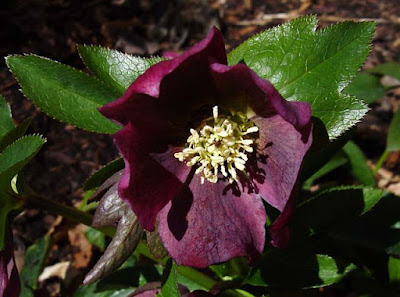
For white, I have chosen Leucojum aestivum, the so-called Summer Snowflake, which always blooms in late winter or early spring around here. These seem happy just about everywhere I've planted them, are very tolerant of moisture and will not rot even in mucky soils. As far as my color scheme goes, these flowers are white, but add a bit of green to the tip of each of the six petals. 
Blue is provided by Ipheion 'Rolf Fiedler', a little bulb from Argentina with star-shaped, bright blue flowers. Although its flowers are sweetly scented, it's not the best cut flower because if a stem or leaf is broken the first thing noticed is a familiar pungent odor, that of its close relatives, the onions. 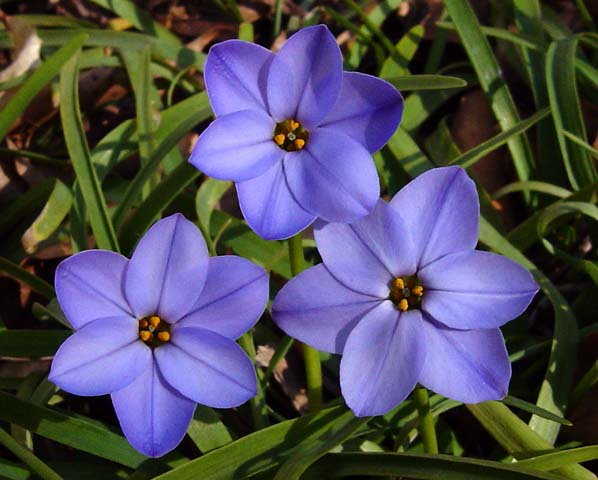
'Jumblie' and 'Ceylon'
The temperatures in central North Carolina have bounced around a bit during the past week or so, but there have been no extremes and that's good for the daffodil show. Two more early varieties have come into bloom since my last post and I have some pictures to share.
Narcissus 'Jumblie' is first, it's a sister seedling of the very popular N. 'Tête-à-tête'. Like 'Tête-à-tête', it's an early bloomer with yellow petals and a yellow-orange cup, but 'Jumblie' has very reflexed petals, showing much more influence from N. cyclamineus. Because scale is often hard to show in flower pictures, especially close-ups, 'Jumblie' might be compared to 'Jetfire', but 'Jumblie' is a much smaller plant and the cup has much less orange.

Narcissus 'Ceylon' is next, and it's a favorite of mine, along with its near twin, N. 'Pinza'. In my garden, these two are hard to tell apart, but 'Ceylon' is consistently shorter and blooms a little later. 

Although Narcissus are providing most of the color in the garden right now, other plants, such as Helleborus, Leucojum, and Ipheion, are beginning to bloom, so I'll focus on them in my next post.
Friday, March 2, 2007
A few more early Narcissus
In my previous post I mentioned that some other Narcissus were preparing to bloom. They are not at peak bloom yet, but enough flowers have opened that I've been able get some pictures of them over the past few days.
The first is Narcissus 'Saint Keverne', a yellow flower that's classified as a large cup, but its cup is not as wide as many and is fairly long, so it could almost qualify as a trumpet. 'Saint Keverne' is known to be especially resistant to basal rot and a good substitute for the less heat tolerant trumpets in warmer climates, but it also performs well in colder climates.

Next is Narcissus 'Pinza', one of my favorites, also classified as a large cup. Its thick, nicely-shaped petals are an intense yellow that almost glows and it adds to that a contrasting reddish-orange cup. Because of the extra thick petals the flowers stand up well to hot sun, cold, wind and rain and remain fresh for weeks. If that's not enough, the bulbs bloom reliably every year and multiply well.
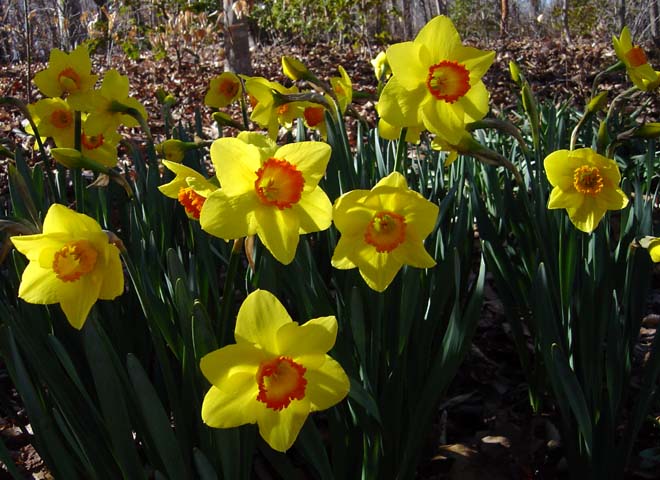
Last one featured in this post is Narcissus 'Carlton', also classified as a large cup, and is reported to be the most abundant Narcissus in cultivation in the world. That's probably because it performs well nearly everywhere and multiplies well. Compared to 'Saint Keverne' its cup is shorter with a wider, more flared out rim.

That's all for now, next up is a sister seedling of 'Tête-à-tête' named 'Jumblie'. Also coming soon is 'Ceylon', a close match to 'Pinza'.








